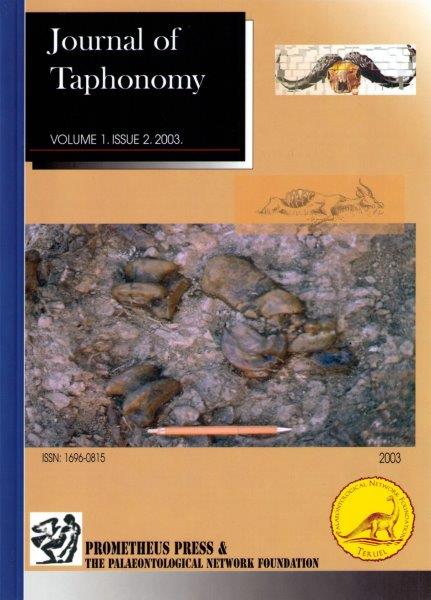


Leonard R. Brand, Michael Hussey, John Taylor.
Keywords: TAPHONOMY, VERTEBRATE, DECAY, DISARTICULATION, BIOSTRATINOMY, EXPERIMENTAL TAPHONOMY
A study was conducted to examine the timing and nature of decay and disarticulation in small vertebrates, using an experimental regime that allowed comparison among different environments, and different size classes of amphibians, reptiles, birds, and mammals. Decay and disarticulation of freshly killed small vertebrates was documented in freshwater and seawater aquaria as well as outdoor terrestrial settings protected from scavengers by partially buried cages. Experimental animals included salamanders (two sizes), lizards, finches, doves, mice, rats, squirrels, and rabbits. The study area was hot and dry (southern California), with scattered winter rains. Some specimens of each species in the terrestrial environment were transferred after about one month to one of two other environments - freshwater, or an outdoor terrestrial cage simulating increased rainfall. In water the carcasses' flesh decayed by bacterial action in one to six months, but insect larvae removed the flesh from terrestrial carcasses within two weeks, leaving dry, desiccated carcasses that changed little over a four to 11 month period. The process of decay and disarticulation was greatly affected by differences in properties of the skin between species and the reaction of each type of skin to drying or water saturation. Disarticulation time was shortest in water, followed by the high rainfall treatment, then dry terrestrial environment. The sequence of disarticulation varied considerably, especially in the terrestrial treatment, but heads and limbs tended to separate from the body first, and then individual bones separated from the limbs. Also, the pattern of tooth loss or cracking differed among environments. These data provide an actualistic analogue to assist in the interpretation of some parameters of fossil assemblages, including maximum time between death and burial of partially or fully articulated small vertebrate fossils (about 3 months in water, but over a year in dry terrestrial conditions), or the likely paleoenvironment in which an assemblage accumulated.
Oliver Wings
Keywords: AQUATIC, BIRDS, DECOMPOSITION, DISINTEGRATION, GASTROLITHS, STRUTHIO CAMELUS, TERRESTRIAL, VERTEBRATE TAPHONOMY
The decomposition of two ostrich (Struthio camelus) chicks (body masses 2.1 kg and 11.5 kg) was observed in a terrestrial and an aquatic setting, respectively, in a hot and arid climate with temperatures ranging from 25-40°C. Special attention was given to the observation of the release of gastroliths from the body cavity. The results show that the gastroliths can be set free from carcasses with a body weight <12 kg after relatively short periods (3-6 days), and that a separation in an aquatic environment is likely because of prolonged floating of the carcass.
Geoff M. Smith.
Keywords: TAPHONOMY, SPIRAL FRACTURING, SCHÖNINGEN, BOXGROVE, WOODEN SPEARS
Experiments with lamb carcasses were used to investigate whether any identifiable "damage signatures" are imparted by wooden spears on bones and whether these differ between a javelin and a thrusting spear. The data from the experiments demonstrated no distinction in damage caused by the two types of spears. Both spears caused high frequencies of saw-toothed fractures on ribs and vertebrae and the javelin inflicted a spiral fracture on a humerus. However, the most conclusive evidence of projectile usage was in the form of puncture wounds on scapulae. Some of the experimental damage recorded is similar to that caused by other taphonomic processes. These experiments illustrate the effectiveness and durability of wooden spears as potential hunting implements and provide insight regarding the tools, technology and subsistence strategies of Middle and Late Pleistocene hominids.
Briana L. Pobiner, Robert J. Blumenschine.
Keywords: OLDOWAN, HOMINID, TAPHONOMY, CARNIVORY, FOSSIL CARNIVORANS, TOOTH MARKS, BONE MODIFICATION, PALEOGUILD
We argue that the evolutionary significance of prehistoric hominid carnivory will be better appreciated if taphonomic tests for evaluating the initial encroachment on the larger carnivoran paleoguild by Oldowan hominids are developed and applied to zooarchaeological assemblages. We propose that the development of taphonomic tests should be guided by three premises: 1) taphonomic measures used to test scenarios of hominid carnivory should be free of interpretive equifinalities; where equifinalities are currently suspected, these must be identified and broken; 2) carnivorans are not a single, homogeneous, taphonomic agent; actualistic research is needed to differentiate the preservable feeding traces of individual carnivore taxa; 3) multiple carnivore species should be assumed to have been involved in creation and modification of bone assemblages; the recognition of the timing and nature of the access of each carnivore to prey carcasses should be sought.
We offer some fundamental steps in developing a methodology to satisfy this research agenda, integrating information from naturalistic observations of carnivoran feeding on mammalian prey carcasses, actualistic studies that simulate the timing of hominid access to these prey carcasses, and functional aspects of presumed carnivoran paleoguilds defined by carcass size-specific edible tissue specialization and bone modification capabilities. We focus on skeletal element and element portion profiles in conjunction with the incidence, anatomical distribution and morphology of tooth marking as the relevant taphonomic measures. The ultimate goal is to diagnose and zooarchaeologically identify unambiguous traces of individual carnivoran taxa and ecological scenarios involving feeding sequences by multiple carnivore taxa, including hominids.